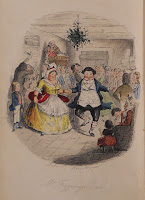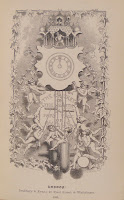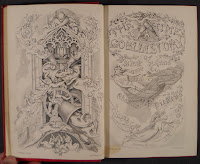 Everybody knows the classic tale of Ebenezer Scrooge and the three ghosts of Christmas whose visitations cause the former miser and all around misanthrope to reform. The other novellas of Christmas penned by Charles Dickens have not stood the test of time as well, perhaps due to lack of such memorable characters like old Mr. Fezziwig.
Everybody knows the classic tale of Ebenezer Scrooge and the three ghosts of Christmas whose visitations cause the former miser and all around misanthrope to reform. The other novellas of Christmas penned by Charles Dickens have not stood the test of time as well, perhaps due to lack of such memorable characters like old Mr. Fezziwig. The first followup to A Christmas Carol (London: Chapman & Hall, 1843) was The Chimes (London: Chapman and Hall, 1845). Despite the inevitable happy ending, this story is a bleaker, more pointed critique of social issues of the 1840s. The goblins in the tale offer the main character glimpses of his family's potential future - each an illustration of how seemingly good people can become trapped in a cycle of evil.
 The Cricket On The Hearth (London: Bradbury and Evans, 1846) is the third in the sequence. After several trials and tribulations, the spirit of the hearth cricket reminds the various characters of their potential for good and the futility of suspecting the worst of others.
The Cricket On The Hearth (London: Bradbury and Evans, 1846) is the third in the sequence. After several trials and tribulations, the spirit of the hearth cricket reminds the various characters of their potential for good and the futility of suspecting the worst of others.The Battle Of Life (London: Bradbury & Evans, 1846) omits the supernatural elements of the first three tales and instead focuses on the selfless acts of the daughters of the cynical Doctor Jeddler. Their devotion and caring brings about a change in his view of the world.
The final novella is The Haunted Man And The Ghost's Bargain (London: Bradbury & Evans, 1848). In this story, Dickens reenlists the aid of a supernatural entity to bring about the redemption of the main character whose initial bargain with his ghostly double to remove all painful memories brings calamity on all others he interacts with as they are also shorn of any unwanted thoughts, leaving them thoughtless and cruel. The lost memories and human feeling of all are returned through the inherent goodness of Milly Swidger whose own painful memories are the source of her benevolence.
Ask for Rare Book PR 4557 .C58 1843 (A Christmas Carol), Rare Book PR 4557 .C5 1845 (The Chimes), Rare Book PR 4572 .C78 1846 (The Cricket On The Hearth), Val 826 D55 O53 (The Battle Of Life), and Rare Book PR 4557 .H3 1848 (The Haunted Man and The Ghost's Bargain).






